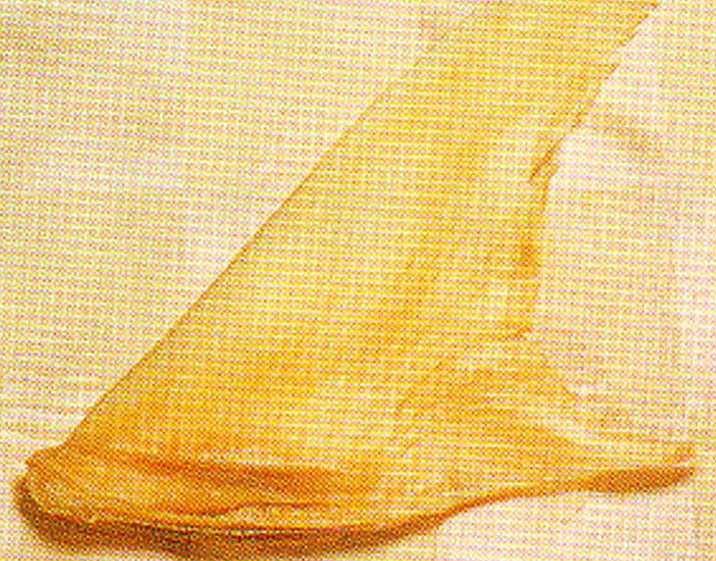
| What is Flavor and Fortune? |
| How do I subscribe? |
| How do I get past issues? |
| How do I advertise? |
| How do I contact the editor? |
Read 12989940 times
Connect me to:
| Home |
| Articles |
| Book reviews |
| Letters to the Editor |
| Newmans News and Notes |
| Recipes |
| Restaurant reviews |
| Article Index (all years, slow) |
| List of Article Years |
| Article Index (2025) |
| Article Index (last 2 years) |
| Things others say |
| Related Links |
| Log In... |
| Authors |
| Categories & Topics |
Shark's Fins
| by Jacqueline M. Newman |
Unusual Ingredients
Spring Volume: 2007 Issue: 14(1) page(s): 5 and 26
 Shark's fins are highly valued by the Chinese worldwide. They are also important to other Asians including the Koreans whose current ruler espouses that shark's fin soup is one of his most favorite foods. He is not the only ruler with that opinion, China's early emperors felt the same way.
Shark's fins are highly valued by the Chinese worldwide. They are also important to other Asians including the Koreans whose current ruler espouses that shark's fin soup is one of his most favorite foods. He is not the only ruler with that opinion, China's early emperors felt the same way.
These days, consuming shark's fin can be a controversial topic. However, the Chinese would rather discourse on which shark's fin rather than on should they not eat this honorific food. What is serious to them is which fin; any fin will not do. Other important topics to expound on are how to properly dry them and how to cook this ancient and adored food. The Chinese really want to eat them if they can afford to. Why? Because shark's fins are considered strengthening and restorative; and in addition, are said to stimulate sexual appetite. Furthermore, the Chinese are accustomed to them at important banquets, weddings, birthday parties for elders, and all auspicious business gatherings. Shark's fins are said to make or repair relations.
One reporter once asked us when shark's fins first became important to the Chinese; he believed it was shortly after Chairman Mao's demise. Not so, we retorted, because they have been popular since the beginning of the Song Dynasty (960 CE), if not before. Since these early times, shark appendages were prestigious markers at banquets. Thus, for hundreds of years they have been served at imperial meals. What is less sure is that their first use is not tied to a specific date or place. Many early emperors adored serving them. We never read of one monarch not eating them.
Was it because they knew sharks clean the oceans? Doubt that. Did they understand they were scavengers eliminating old and ill creatures and keeping unwanted species in check? Doubt that, too. Most Chinese are not worried about any of this. Their main concern is if they can afford them prepared in a soup or braised in a superior sauce. Researchers and environmentalists can be concerned that one day there may be no sharks but most Chinese never think about that. They may think that sharks will swim for several hundred million years more and that they will be there for them to enjoy.
Do the Chinese know that a shark must be in its teens before reaching sexual maturity? Do they worry about the average shark only producing a few offspring a year? Do they care that many sharks do not live to maturity? What is known, but not by them, rather by environmentalists and researchers, is that merchants in Hong Kong handle thousands of tons of shark fins yearly. Do they know this means tens of millions of sharks are killed in order to grace the banquet tables that feature them? Doubt that they do.
Disney's Hong Kong management has taken action. In this city that adores dishes made with shark's fins, they removed shark's fin soup from all wedding banquet menus. Some wonder if non-Chinese environmental pressures were at play. Disney folk say, "After careful consideration...we were not able to identify an environmentally sustainable fishing source...for the fins on our wedding banquet menus."
Yao Ming, the seven-foot six-inch US National Basketball Association star, recently agreed even though he once played for a team called the Shanghai Sharks. Why did he say nothing when he was a Shark? At a recent Beijing WorldAid Press Conference, he pledged never to eat anything containing shark's fin again. The Chinese press adores him but ignored his message. Perhaps it was because a large number of his countrymen do not agree with his pronouncement; they still delight in eating this outrageously expensive food item.
There is one thing the Chinese do dislike about shark's fins. That is sending even a tiny strand of them back to the kitchen. They believe every morsel must be consumed. They pay little heed to the fact that seventy percent of shark's fins contain hazardous levels of mercury. Do they and Yang Ming know consuming mercury can cause sterility, birth defects, and loss of brain cells? Do they care?

 Most Chinese want shark's fin soup served at the weddings and other banquet meals they attend. They delight when getting them any time. When hosting such an affair, they worry when no shark's fin is on the menu they may lose face. They say they are needed and part of their culture. Americans, they note, would feel the same with no turkey at a Thanksgiving dinner. They want their shark's fin in soup or served with meat, greens, and/or medicinals. Protesters do not deter them.
Most Chinese want shark's fin soup served at the weddings and other banquet meals they attend. They delight when getting them any time. When hosting such an affair, they worry when no shark's fin is on the menu they may lose face. They say they are needed and part of their culture. Americans, they note, would feel the same with no turkey at a Thanksgiving dinner. They want their shark's fin in soup or served with meat, greens, and/or medicinals. Protesters do not deter them.
Those who are concerned try to suggest ways to develop and/or use environmentally sustainable species as does Disney Hong Kong. They applaud efforts to regulate their harvest but do not appreciate those that remove these culinary icons from their tables.
The Chinese like to eat foods with aphrodisiac properties; these enhance their qi. They point out that eating shark's fin in soup or braised in a superior sauce does that; and they appreciate them philosophically, culturally, and in reality. They adore dried pale yellow ones and are willing to pay the going exorbitant price to get them. Very few bow to environmental pressure while others stay mum if served mock shark's fin though they prefer the real thing. When asked and admitting their desire for the real thing, they point to historical records that report shark's fins were never omitted from any imperial first or second class meals.
This magazine published a Snake and Shark’s Fin Casserole recipe in an article titled: Unusual Ingredients that Some Call Precious, Others Exotic. It was in Volume 2(3) on pages 11 through 13. No one complained then; actually the opposite has been true. This recipe is one among the three most requested ones. Long out of print, it can be found at www.flavorandfortune.com
 The Chinese call shark, sha yu; their fins are called yu qi. They prefer their fins from sharks less than five feet in length. Many want the pectoral fin from the species known as Prestis pactinatus. These are adored as are the upper lobe of this species and its tail fins. They want their shark's fins whole, not broken.
The Chinese call shark, sha yu; their fins are called yu qi. They prefer their fins from sharks less than five feet in length. Many want the pectoral fin from the species known as Prestis pactinatus. These are adored as are the upper lobe of this species and its tail fins. They want their shark's fins whole, not broken.
Not everyone agrees which fin is best; some prefer the dorsal fin or the two vertical ones. Those who claim to prefer broken fins probably do so because of their cost. These cost less than half of what a whole one would. A fin of good color, size, and shape sells for a couple of hundred US dollars.
 Getting fresh shark's fins is no easy task. First, one needs to capture the shark. Then the task is severing the fin or fins. After the fins are cut off, most fishermen throw the shark back and leave it to die. They treat the fin with more respect. One way of handling it is skewering it between two special bamboo mats. Fins are handled carefully to assure that a single bowl of soup with a small whole fin will bring in a hundred or two hundred American dollars.
Getting fresh shark's fins is no easy task. First, one needs to capture the shark. Then the task is severing the fin or fins. After the fins are cut off, most fishermen throw the shark back and leave it to die. They treat the fin with more respect. One way of handling it is skewering it between two special bamboo mats. Fins are handled carefully to assure that a single bowl of soup with a small whole fin will bring in a hundred or two hundred American dollars.
However, most Chinese do not use fresh fins, they prefer dried ones. We reported about the only book devoted solely to this food. It is called Talking About Sharksfin Cooking Ways and is by Hua Huisheng. It was reviewed in Volume 13(2) on pages 25 and 26. On page 20 of that same issue we did discuss and illustrate a phenomenal Shark's Fin Soup enjoyed at the Fu Yuan Restaurant; 17 Lin Yi Street; Taipei, Taiwan. That restaurant and the soup were reviewed in that same issue, on pages 20 and 21.
Shark's fins are not just used in soups or braised in casseroles. They can be prepared with crab meat and/or crab roe, or cooked with scrambled eggs. They might be stuffed in a steamed or roasted duck, or pleated in delicious dumplings. Preparing them for these and other dishes takes several days if using fresh fins, only hours if using dried ones.
Fresh fins need to be skinned and scraped of mucilaginous material. Then they must be scrubbed, soaked, and boiled in several changes of water and/or superior stock. The last time one boils them, it is best to do so in a richly seasoned chicken stock with or without preserved ham in it. Shark's fins fall apart in the cooking process, leaving only shark fin needles. That is why they are prepared as seen in the illustration, between two woven bamboo mats. They can also be wired in some other way.
The best information on how to dry and prepare shark's fins can be found in F.T. Cheng's Musings of a Chinese Gourmet published by Hutchinson in London in 1954. Reading this discussion is an academic delight. Cooking shark's fins from the dried state is delightful, too.
The recipes below all use dried shark's fins. When buying yours, look for those with long unbroken needles. Keep in mind the best ones are the pale ones. Afficionados know to buy the most expensive fins they can afford. They also know that pieces of shark’s fin hold sauce and flavorings better than single strands.
We also recommend reading Characteristic Bird's Net & Shark Fin & Abalone (the mis-spelling of Nest is as in the book). It was compiled by De Lin, Guorong Liang, Jianfan Li, and others, and published in Guangzhou, China by the Guangdong Lu Yu Publishing Company in the year 2002. This book has more than one hundred recipes that use shark's fins. Chinese chefs tell us that is a small sample of known shark's fin dishes. This magazine has printed quite a few recipes for this adored food such as the two in Volume 13(2) on pages 25 and 26. Look for them and others in the index listings on this magazine's web site: www.flavorandfortune.com
To prepare dried shark's fins, begin with putting them in a pot with lots of cold water. Slowly bring the water to the boil, then quickly reduce the heat. Simmer them in this water for ninety minutes. Remove the pot from the heat source and allow the fins to cool in the water. Discard the water and carefully rinse them in cold water. Then put them in a clean pot covered with fresh cold water. Cover and refrigerate this for six or more hours. Next, bring this water and the fin(s) to the boil again, and quickly reduce the heat. Simmer this for sixty minutes, then cool as before. Remove any skin or debris (use tweasers) before using them in any recipe below or elsewhere.
If you have environmental concerns, consider some of the non- or less-endangered species, or enjoy imitation shark's fins. Thin mung bean noodles are good substitutes in shark's fin soups, casseroles, and dumpling recipes. They cook clear, look like the real thing, and their texture is resilient yet soft; and in addition, they carry the accompanying flavors beautifully.
A last comment for Chinese and others who do eat and enjoy real fins. A study done at the Massachusetts Institute of Technology in conjunction with Children's Hospital in Boston shows that consuming the cartilage in shark's fins strongly inhibits the growth of new blood vessels that feed solid tumors. For those worrying about eating these ecologically sensitive creatures who also have a cancerous tumor, yours is a tough decision.
Shark's fin recipes will appear in the next issue.

Copyright © 1994-2025 by ISACC, all rights reserved
Address
3 Jefferson Ferry Drive
S. Setauket NY 11720